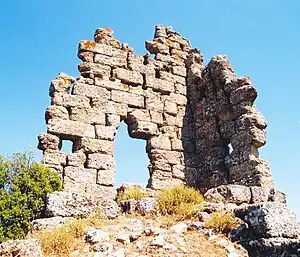Cyrtones
Cyrtones or Kyrtones (Ancient Greek: Κύρτωνες),[1] anciently called Cyrtone or Kyrtone (Κυρτώνη), was a city of Boeotia, east of the Lake Copais, and 20 stadia from Hyettus, situated upon a lofty mountain, after crossing which the traveller arrived at Corsia. Cyrtones contained a grove and temple of Apollo, in which were statues of Apollo and Artemis, and a fountain of cold water, at the source of which was a chapel of the nymphs.[2]

The site of Cyrtones is tentatively located at Kastron Kolakas/Karaouli, near the modern village of Kyrtoni, which was renamed from Kolaka to reflect association with the ancient town.[3][4] The remains of a walled enclosure, and of a building, possibly a temple, have been found.[5] This ancient fortification has a square tower made out of 1.5 m thick stones. From the ancient fountain now known as Kamini flows brackish, ice cold water with healing properties (for dysentery).[6]
References
- Stephanus of Byzantium. Ethnica. Vol. s.v.
- Pausanias (1918). "24.4". Description of Greece. Vol. 9. Translated by W. H. S. Jones; H. A. Ormerod. Cambridge, Massachusetts; London: Harvard University Press; William Heinemann – via Perseus Digital Library.
- Richard Talbert, ed. (2000). Barrington Atlas of the Greek and Roman World. Princeton University Press. p. 55, and directory notes accompanying.
- Lund University. Digital Atlas of the Roman Empire.
- Fossey, J. M. (1990). The Ancient Topography of Opountian Lokris. Amsterdam: Gieben. pp. 52–57.
- Phthiotis Prefectural Council Archived 2009-05-27 at the Wayback Machine (in Greek)
![]() This article incorporates text from a publication now in the public domain: Smith, William, ed. (1854–1857). "Cyrtones". Dictionary of Greek and Roman Geography. London: John Murray.
This article incorporates text from a publication now in the public domain: Smith, William, ed. (1854–1857). "Cyrtones". Dictionary of Greek and Roman Geography. London: John Murray.